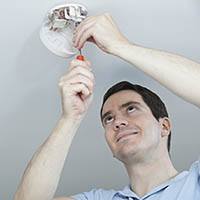

By testing your alarm monthly and replacing the battery at least yearly, you should avoid most problems. But if you’re having issues with your smoke alarm, our troubleshooting guide is here to help.
Why is My Smoke Alarm Going Off When There’s No Fire?
First and foremost, check your surroundings closely to make sure that there is definitely no fire. Next, visit the kitchen to make sure nothing is burning or smoking. Steam can also set your alarm off, so when you’re in the shower, open a window or use the exhaust fan.
There could also be some dust or dirt in the smoke alarm that’s interfering with its sensors, so be sure to clean it regularly, and vacuum out any loose particles or insects that have found their way in. High humidity can create problems, as water vapours can get in the smoke sensor, which can result in a false alarm. If humidity is the problem, you can use a hairdryer to dry it out.
Smoke alarms located near air ducts or fans can also false alarm due to the high air movement, and you may need to relocate them if the alarm is causing you grief.
Why is My Smoke Alarm Chirping?
If you’ve only just installed it, make sure you’ve removed the yellow battery installation tag. If your smoke alarm is not new, and runs on 9V batteries, it will chirp at regular intervals when the battery needs to be replaced. Get a new battery as soon as possible and follow the manufacturer’s instructions in your User Manual to correctly change it.
If your smoke alarms run on non-replaceable batteries and you are experiencing chirping, contact our technical team for support. Smoke alarms have a lifespan of 10 years – so if yours is around 10 years old, it may be close to expiry and need to be replaced.
Some smoke alarms have a Hush feature, which is designed to desensitize the alarm and avoid false alarms. When you press the Hush button it will chirp or beep for 5-10 minutes to indicate Hush mode is active. The smoke alarm will automatically reset after the 5-10 minute chirping cycle is over, but if you press the Hush button again first, it will reset the cycle and the alarm will chirp for another 5-10 minutes.
I’ve Changed the Battery – But It’s Still Chirping?
First check the battery terminals are in contact with the battery, and give the smoke alarm a clean with a vacuum to suck out any dust particles. If your alarm has a Hush mode, it’s possible the button may have been accidently pushed when the battery was changed. If it’s still chirping when attached to the ceiling, it could be in Hush mode – leave it for 5-10 minutes without pressing any buttons, to allow it to complete the Hush cycle.
I’ve Installed My Smoke Alarm – How Can I Be Sure It’s Working?

How Do I Remove My Smoke Alarm from The Mounting Base?
This will depend on the model you have, so consult your user manual for specific instructions. For Lifesaver series smoke alarms, remove the tamper locking pin and separate the unit from the base by sliding in the direction of the Slide to Remove arrow embossed on the top of the smoke alarm.
If your alarm is from the Homeguard series, remove the tamper locking pin and twist in a clockwise direction to remove from the base, then disconnect the fly lead by squeezing the sides.
How Do I Replace the Battery?
If your smoke alarm runs on replaceable batteries, make sure you change them at least yearly. Locate the battery compartment door on the bottom of the smoke alarm, remove the old and replace with a new 9V battery.
Make sure you insert the battery the right way so that the polarity is correct, and also remember to fold the red battery lever down into the battery compartment too – if you don’t the smoke alarm won’t close or operate. Once you’ve installed the new battery, press the Test button to check it’s working, then reinstall back onto the base.
How Often Do I Need to Replace My Smoke Alarms?
Both hard-wired and battery operated smoke alarms are manufactured to have a recommended service life of at least 10 years of normal use (AS 3786). This is why both Australian Standards and Fire Authorities recommended that all smoke alarms should be replaced after 10 years.
Smoke alarms are operational 24 hours a day – so after 10 years they have gone through millions of cycles and can become less reliable. Smoke alarms that are older than 10 years may malfunction, which means they can potentially fail to detect a fire. So don’t risk it – make sure you’re protected by replacing your old smoke detectors.
Still have Questions?
If you need further information, get in touch with our friendly team – we are experts in emergency products and will happily answer any questions and provide expert advice.

